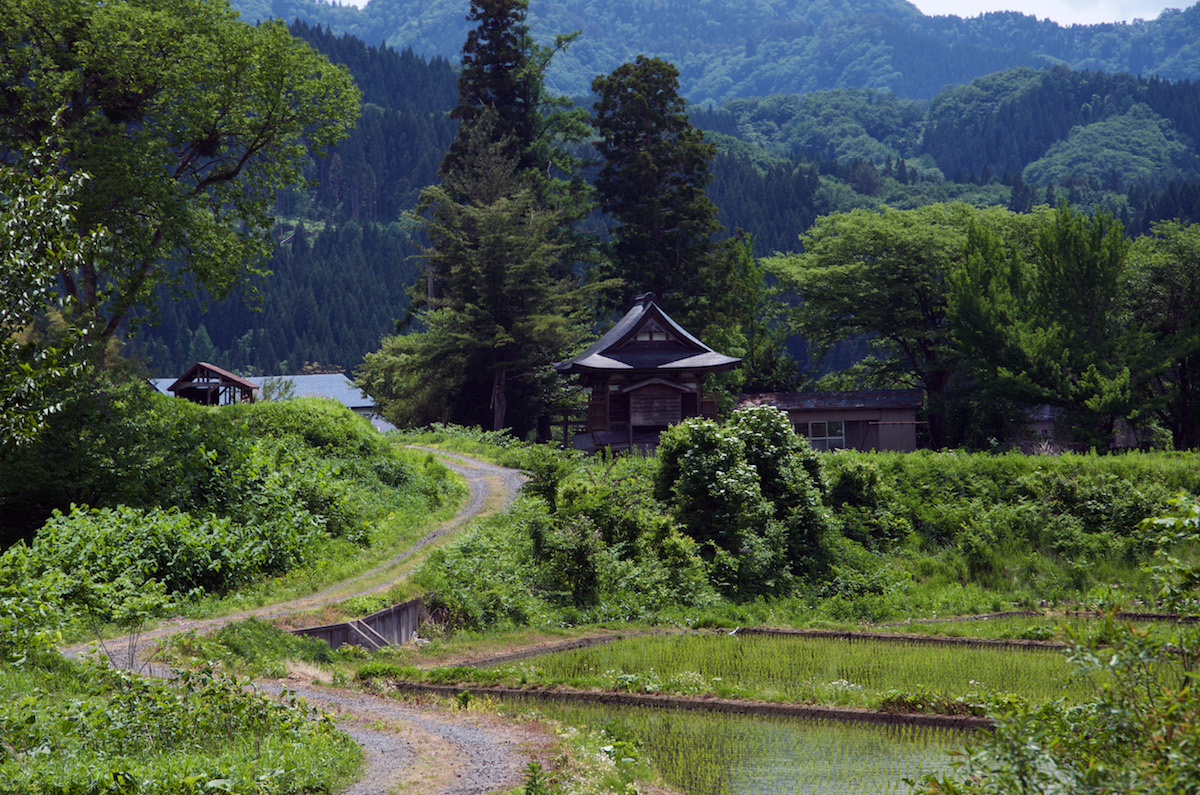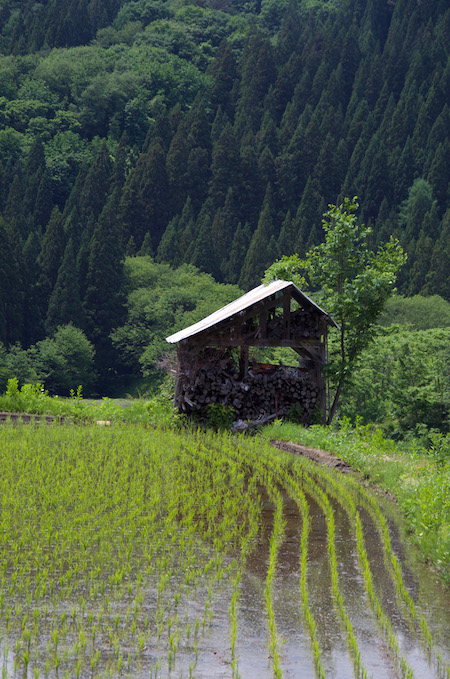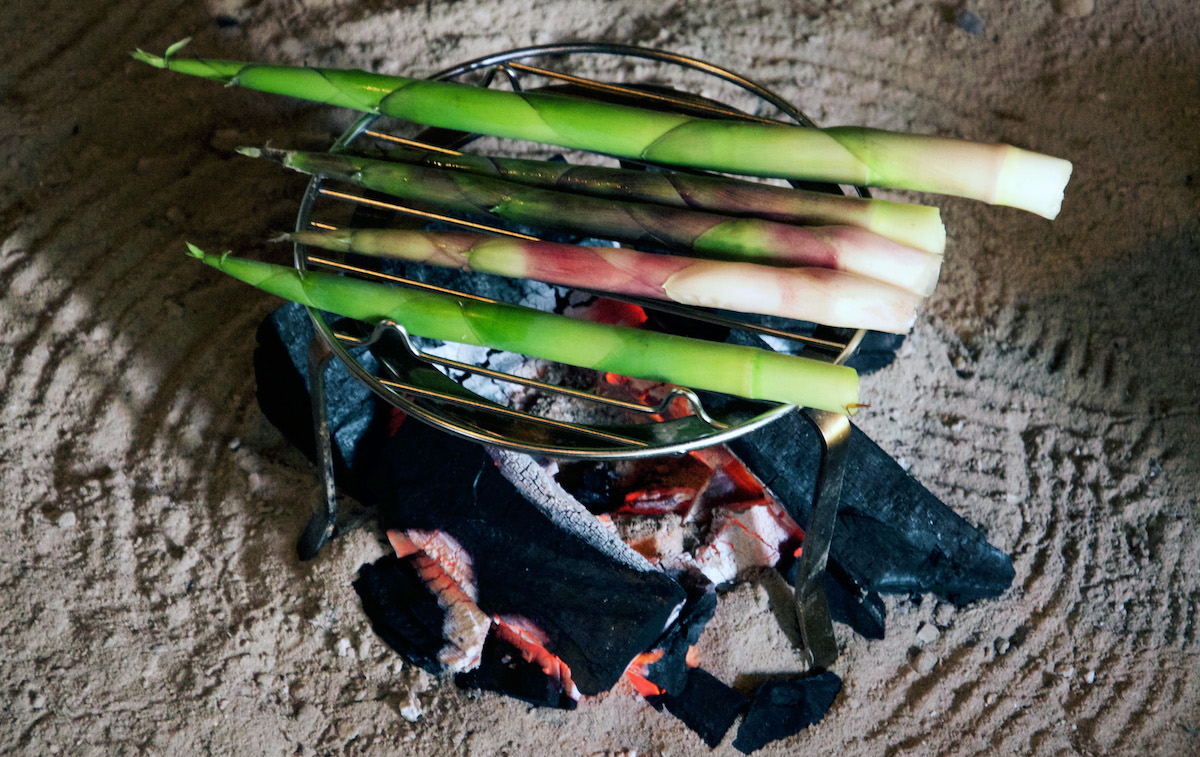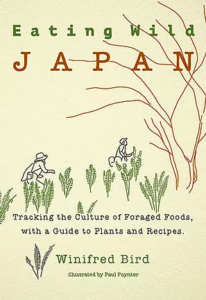
Foraging for Wild Edible Bamboo on Mount Moriyoshi
Winifred Bird Ventures Into the Woods with a Bear Hunter and a Train Conductor
In early June of 2019, I found myself crouching in a beech forest near the peak of Mt. Moriyoshi in Akita Prefecture with a bear hunter and a train conductor, scanning the ground for wild takenoko (bamboo shoots). Specifically, we were looking for the new shoots of chishimazasa, also called nemagaridake, a slim, relatively short variety of bamboo that grows in vast thickets across snowy northern Japan. Nemagari means “bent-root,” a reference to the fact that the shoots emerge from the ground at odd, low angles and only straighten as they mature. Thus the need to crouch; if we didn’t, the shoots blended in bewilderingly with the jumble of beech saplings, old bamboo stalks, and fallen leaves and twigs on the forest floor.
My head inches from the ground, I trained my eye up the steep slope, past a mossy snag and a cluster of ferns—jackpot! The thrill of discovery shot through me. I scrambled up the slope, grasped the slender shoot firmly at its base, and pulled. With a satisfying squeak that hinted at the juicy flesh inside its sheath, it snapped off in my hand, and I added it to the bundle already in my bag.
I thought back to the manicured groves of mosodake I’d visited in Kyoto, the ground below them soft with rice hulls and the still air broken only by the silky rustling of bamboo leaves high above (mosodake is the most commonly eaten species of bamboo in Japan, introduced from China as a cultivated crop in the eighteenth century). Then I looked around at the beautiful, messy, gnat-and-mosquito-infested beech forest of Mt. Moriyoshi, here in the far north of Honshu, burgeoning with all the pent-up life that had been sealed underground over the long winter. Never was the difference between wild and cultivated so clear. Those moso groves had a quiet, hard-earned beauty to them, but the sasa thicket had excitement: the thrill of the hunt, and of life unfolding beyond my control, subject to the whims of rain and sun and earth. Could anything compare to those brief moments when the universe aligned to give me a perfect, vibrant, tender shoot, so easy to overlook and so elementally gratifying when I managed not to?
“We have the mountain goddess to thank,” the bear hunter, Hideyuki Oriyama, had said as he drove the three of us up the mountain half an hour earlier, just after dawn. We were talking about how excellent it was that the emergence of the shoots had lined up perfectly with my arrival. His mention of the mountain goddess wasn’t at all metaphorical. It is a custom of the matagi—as traditional hunters of northern Japan are called—to pray to the goddess before hunting on her mountain and to thank her when she permits them to catch a bear. In Oriyama’s words, she is a “not very pretty” deity who becomes exceedingly jealous when beautiful women enter the forest but likes men very much and sometimes keeps them for herself when they come hunting. To appease her, the hunters offer her sake and a hideous spiny fish called okoze (“devil stinger” in English), which they believe makes her feel better about her own appearance.
One by one we stripped off the thick husks to reveal the moist, glowing, yellow-green spikes inside. These we sprinkled with salt and ate steaming hot.
I was staying at the guesthouse Oriyama runs with his wife in the nearby farming hamlet of Nemorida and had asked his help in arranging an outing to pick takenoko. This had led to the introduction of the train conductor, Takumi Sugibuchi, a weekend mountaineer who sold nemagaridake in addition to driving the one-car train that had carried me, my sister, and my ten-month-old son through the mountains to Oriyama’s guesthouse earlier that week. Sugibuchi had arrived at the guesthouse at 4:30 that morning, his standard departure time for picking takenoko. He had close-cropped, wavy black hair, rectangular black-rimmed glasses, and a trim frame clad in a pair of those blue coveralls that in Japan signal one’s intent to do serious work. He told me that although he had grown up in a small town not far from the guesthouse and had always loved to climb mountains, he only began foraging for wild foods five or six years before I met him. An older colleague was retiring from the train company and Sugibuchi wanted to find a way to keep up their friendship. As it turned out, the man was an expert forager, and since Sugibuchi was already a passionate alpinist, he became his apprentice. The old forager, he said, had an uncanny ability to walk at a steep angle up and down the slopes, a keen sense of where to find particular plants, and a complete comfort in the mountains.
In contrast to Sugibushi, Oriyama grew up in the prefectural capital, a stereotypical city kid who loved video games and disliked going to his grandparents’ house in Nemorida. When the earthquake, tsunami, and nuclear disaster of March 11, 2011, hit, he was living far to the south in Tokyo, the older of his two daughters just three months old (she was eight when I visited). Suddenly he realized their vulnerability. Everything from diapers to food was brought in from elsewhere, and even the water was polluted by fallout. He felt that if his family moved to the country, they would have a certain degree of security; at least in the mountains, there would always be something to eat. Soon after, they returned north to Nemorida and turned the empty ancestral home into a guesthouse.
 Nemorida, Japan. Photo courtesy of Winifred Bird
Nemorida, Japan. Photo courtesy of Winifred Bird
They were the youngest family in a village full of elderly farmers who could no longer keep all their fields mowed and fruit trees picked. The boundary between the forest and the farmland had begun to blur. Bears would wander into town to pick persimmons and raid the snacks set before gravestones as offerings to the dead, causing an uproar. Sadly enough, shooting them was the usual solution, but only one person in the village had a gun permit: Oriyama’s 83-year-old neighbor. When he died, no one was left. So Oriyama became a matagi, as men of his village had done for centuries. He said he felt he had to protect his family and community, to “teach the bears that humans are frightening beings.” The meat was a side benefit. When I met him, he had been a hunter for five years.
I was fascinated by how wholeheartedly he had embraced matagi culture, even though it was fairly new to him and only a small part of his livelihood (he worked full-time at the local dam). “Our culture straddles the natural and human worlds,” he told me, spreading two fingers apart on a bear-skin rug in the guesthouse living room; the word matagu, from which “matagi” may be derived, means to straddle. Matagi go into the mountains not only to hunt but also to fish and forage for sansai and mushrooms. In Tochi to Mochi (Rice Cakes and Horse Chestnuts), the environmental folklorist Kan’ichi Nomoto details the food-procuring activities of a matagi in Yamagata Prefecture, just south of Akita, in the 1930s. In addition to farming paddy and dryland fields (both permanent and rotating slash-and-burn types), the man hunted bears, flying squirrels, marten, rabbits, and pheasants; fished for six types of river fish; and gathered sansai (wild mountain vegetables), eight types of wild mushrooms, chestnuts, horse chestnuts, wild grapes, walnuts, and mountain yams. It was this way of living in the mountains that Oriyama had begun to experience, albeit in much simplified form.
 Nemorida, Japan. Photo courtesy of Winifred Bird
Nemorida, Japan. Photo courtesy of Winifred Bird
One evening, he showed me a documentary about matagi culture. It was made just 30 years earlier but depicted another world. The elderly men wore thick black-rimmed glasses and fur vests made from the pelts of their favorite hunting dogs so they would not be separated even in death (they never wore bear pelts, lest they mistake one another for an actual bear). They slid down the snowy slopes as fast as skiers and climbed them like antelopes, sleeping in remote huts for a week or more at a time.
Of all the dishes we made, the best by far were those fresh shoots we grilled over the hearth for breakfast: impeccably fresh, entirely uncomplicated, and above all, eaten slowly and sociably.
In the mountains, they spoke a special language and took on set roles to surround and flush out the bears. They never killed more than one a day, gathering round afterward to skin and butcher it, nibbling on pieces of the fat as they did. The meat was always equally divided. The bears they shot with rifles, but the rabbits were victim to an older, rawer method. First, the hunters tossed out woven grass disks that produced a sound like the wings of a crow, sending the rabbits racing for their dens. They then thrashed through the snow after them, pawed their way into the dens like rabbits themselves, and snatched the beautiful white creatures out by their hind legs to kill.
Oriyama said that in the past, a single bear generated enough money for a family of four to live on for a year, but today the value has fallen to a mere few hundred dollars. No one wants the pelts for rugs anymore, because a bear pelt makes a poor match for vinyl flooring, and the sale of various parts for medicinal purposes has been regulated (though a large black market still exists). The number of matagi in the local hunting association has dropped from a hundred to 22. Although regulation is beneficial from a conservation perspective, this drop in the value of the bear struck me as a sad development. It seemed such a hard, cold reflection of how the value placed on all the mountain’s gifts has withered over time.
*
It was around 8:00 by the time Oriyama, Sugibuchi, and I returned from the mountain with our basketful of takenoko and motley assortment of other sansai we’d picked along the way: fiddleheads, shiode (wild asparagus), a couple of young udo (Japanese spikenard) stems, and some mizu (a kind of nettle). My heart was still pulsing with awe at the abundance of the mountain—at all it provides and also at the peculiar way in which the character of those plants so perfectly matches our own needs and wants. I was filled to the brim with that feeling, which I am too urban and unattuned to experience more than once in a great while, of being part of the whole, a small piece in the cosmic puzzle, shaped to fit it just as it is shaped to fit me.
Oriyama started a small charcoal fire for us in the irori of the guesthouse living room, then left for work. An irori is a traditional Japanese hearth, usually square and sunk into the floor, over and around which all sorts of delicious things can be cooked. Sugibuchi, my sister, my son, and I arranged ourselves on the bear-skin rugs around this hearth and began to cook a portion of our takenoko. This was a very simple process. Sugibuchi placed a small metal stand over the charcoal and arranged a handful of the shoots on top. Each was about six inches long and as thick as my thumb at the base, wrapped tightly in a green and pink sheath. After about 10 minutes, when the sheaths lost their dullness and began to glisten with moisture, he pulled them off and handed them around to us.
 Cooking chishimizasa. Photo courtesy of Winifred Bird
Cooking chishimizasa. Photo courtesy of Winifred Bird
One by one we stripped off the thick husks to reveal the moist, glowing, yellow-green spikes inside. These we sprinkled with salt and ate steaming hot. The flavor was delicate and sweet like the end of a corn cob, with a very faint hint of astringency. Little by little the pile of discarded husks beside us grew. I was reminded of a photograph Sugibuchi had snapped on his phone earlier that morning when he ventured up a slope too steep for me to follow. It showed a similar pile left behind by a bear enjoying the same springtime treat as us humans.
Sugibuchi stayed with us until noon, blanching and peeling the rest of the shoots and preparing the handful of other sansai we had gathered. When that was done, we cooked a simple feast of rice, miso soup with takenoko, and tempura made from takenoko and the other sansai. The food was delicious, and the habitually over-scheduled Sugibuchi announced he was delighted to enjoy the pleasure of a leisurely meal. But of all the dishes we made, the best by far were those fresh shoots we grilled over the hearth for breakfast: impeccably fresh, entirely uncomplicated, and above all, eaten slowly and sociably, each one unwrapped and relished like the gift it was.
__________________________________

From Eating Wild Japan by Winifred Bird. Used with the permission of Stone Bridge Press. Copyright © 2021 by Winifred Bird.
Winifred Bird
Winifred Bird is a writer, translator, lifelong cook, and lover of plants both wild and domesticated. From 2005 through 2014 she lived in Japan, where she worked as an environmental journalist, grew organic rice and vegetables, and ate as many foraged foods as possible. Her writing has been published in the Japan Times, NPR.org, Dwell, Pacific Standard, and elsewhere. She currently lives with her family in northern Illinois.



















